
Hedeby was an important Danish Viking Age trading settlement near the southern end of the Jutland Peninsula, now in the Schleswig-Flensburg district of Schleswig-Holstein, Germany. Around 965, chronicler Abraham ben Jacob visited Hedeby and described it as, "a very large city at the very end of the world's ocean."
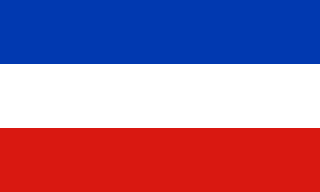
Schleswig-Holstein is the northernmost of the 16 states of Germany, comprising most of the historical Duchy of Holstein and the southern part of the former Duchy of Schleswig. Its capital city is Kiel; other notable cities are Lübeck and Flensburg. It covers an area of 15,763 km2 (6,086 sq mi), making it the 5th smallest German federal state by area. Historically, the name can also refer to a larger region, containing both present-day Schleswig-Holstein and the former South Jutland County in Denmark.

Southern Schleswig is the southern half of the former Duchy of Schleswig in Germany on the Jutland Peninsula. The geographical area today covers the large area between the Eider river in the south and the Flensburg Fjord in the north, where it borders Denmark. Northern Schleswig, congruent with the former South Jutland County, forms the southernmost part of Denmark. The area belonged to the Crown of Denmark until Prussia and Austria declared war on Denmark in 1864. Denmark wanted to give away the German-speaking Holsten and set the new border at the small river Ejderen. Prussian chancellor Otto von Bismarck concluded that this justified a war, and even proclaimed it a "holy war". He also turned to the Emperor of Austria, Franz Joseph I of Austria for help. A similar war in 1848 had gone poorly for the Prussians. With Prussia's modern weapons and the help from both the Austrians and General Moltke, the Danish army was destroyed or forced to make a disorderly retreat. The Prussian-Danish border was then moved from the Elbe up in Jutland to the Kongeåen creek.

The Duchy of Schleswig was a duchy in Southern Jutland covering the area between about 60 km north and 70 km (45 mi) south of the current border between Germany and Denmark. The territory has been divided between the two countries since 1920, with Northern Schleswig in Denmark and Southern Schleswig in Germany. The region is also called Sleswick in English.
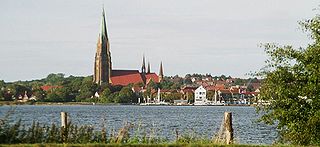
Schleswig is a town in the northeastern part of Schleswig-Holstein, Germany. It is the capital of the Kreis (district) Schleswig-Flensburg. It has a population of about 27,000, the main industries being leather and food processing. It takes its name from the Schlei (Slien), an inlet of the Baltic Sea at the end of which it sits, and vik or vig which means "bay" in Old Norse and Danish. Schleswig or Slesvig therefore means "bay of the Schlei".

Schleswig-Flensburg is a district in Schleswig-Holstein, Germany. It is bounded by the districts of Rendsburg-Eckernförde, Dithmarschen and Nordfriesland, the Region Syddanmark in Denmark, the city of Flensburg and the Baltic Sea.

Swania is a peninsula in Schleswig-Holstein, Germany, protruding into the Baltic Sea. It is located between the Eckernförde Bay to the south and the Schlei inlet to the north.

Anglia is a small peninsula in northern Germany, on the Baltic coast of Jutland. Jutland consists of the mainland of Denmark and the northernmost German state of Schleswig-Holstein. Anglia belongs to the region of Southern Schleswig, which constitutes the northern part of Schleswig-Holstein. The region is often referred to in German as Landschaft Angeln or Halbinsel Angeln.

The Bay of Kiel or Kiel Bay is a bay in the southwestern Baltic Sea, off the shores of Schleswig-Holstein in Germany and the islands of Denmark. It is connected with the Bay of Mecklenburg in the east, the Little Belt in the northwest, and the Great Belt in the North.
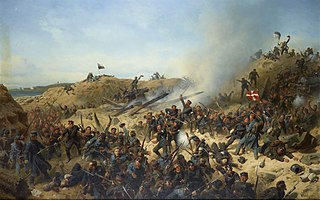
The Second Schleswig War, also sometimes known as the Dano-Prussian War or Prusso-Danish War, was the second military conflict over the Schleswig-Holstein Question of the nineteenth century. The war began on 1 February 1864, when Prussian and Austrian forces crossed the border into the Danish fief Schleswig. Denmark fought troops of the Kingdom of Prussia and the Austrian Empire representing the German Confederation.

The Danevirke or Danework is a system of Danish fortifications in Schleswig-Holstein, Germany. This historically important linear defensive earthwork across the neck of the Cimbrian peninsula was initiated by the Danes in the Nordic Iron Age about AD 650. It was later expanded multiple times during Denmark's Viking Age and High Middle Ages. The Danevirke was last used for military purposes in 1864 during the Second War of Schleswig.

Sønderborg Castle is located in the town of Sønderborg, Denmark on the island of Als in South Jutland. It houses a museum focusing on the history and culture of the area. The castle is located in the middle of the town, in a park setting overlooking Als Fjord. The museum is open year-round.
South Jutlandic or South Jutish is a dialect of the Danish language. South Jutlandic is spoken in Southern Jutland on both sides of the border between Denmark and Germany.

Gottorf Castle is a castle and estate in the city of Schleswig, Schleswig-Holstein, Germany. It is one of the most important secular buildings in Schleswig-Holstein, and has been rebuilt and expanded several times in its over eight hundred years of history, changing from a medieval castle to a Renaissance fortress to a Baroque palace.

Arnis is the smallest town in Germany both by population and by area. At a population of c. 300 and a total area of 0.45 km2, Arnis is part of the Amt Kappeln-Land in the district of Schleswig-Flensburg, in Schleswig-Holstein, Germany. It was founded in 1667 by shipping families from the nearby village Kappeln who wanted to avoid serfdom. The local Skipper's Church was erected in 1673. Originally Arnis was a skipper town with up to 90 sailing-ships (1864). In the late 20th century four shipyards were the basis of its economy. Today Arnis is a tourism showplace.

Southern Jutland is the name for the region south of the Kongeå in Jutland, Denmark and north of the Eider (river) in Schleswig-Holstein, Germany. The region north of the Kongeå is called Nørrejylland, 'Northern Jutland'. Both territories had their own ting assemblies in the Middle Ages. Southern Jutland is mentioned for the first time in the Knýtlinga saga.

The Battle of Sankelmark was a minor battle during the Second Schleswig War. It took place on 6 February 1864 between Sankelmark and Oeversee, on the road between Schleswig and Flensburg, during the Danish retreat from Dannevirke.
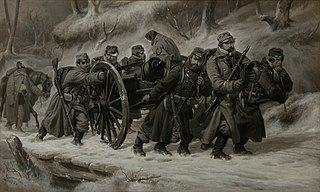
During the Second War of Schleswig, the fortifications of Danevirke were evacuated by the Danish army in 1864. This marked the last military use of the ancient defence structure of Danevirke, which has remained in German possession ever since.
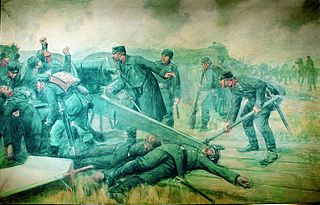
The Battle of Mysunde on 2 February 1864 was the first battle between the Prusso-Austrian allied army and the Danish army in the Second Schleswig War. The Prussian vanguard force of 10,000 men attempted to break through and outflank the Danish defenses at Danevirke, but were repulsed by the fortification garrison and two battalions of the Danish army.

The Battle of Mysunde (1848), or the First Battle of Mysunde took place in the First Schleswig War at Mysunde, Germany. The battle occurred April 23, 1848. The battle resulted in a Danish defeat.



















